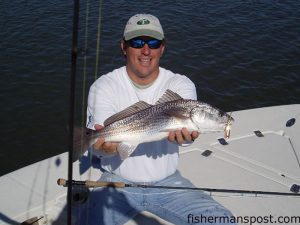Road To Redfish – Fly Fishing With Good Catching

Nicholas Pierce, from Wilmington, with a redfish caught on a crease fly on a flat in the Wrightsville Beach area. He was fishing with Capt. Jon Huff of Circle H Charters.
The redfish are in the shallows. These fish have been cooperating nicely in and around the area lately, and this suits me just fine. I have been fortunate enough to find the fish for a handful of clients these past weeks, including two fly-fishermen (on separate trips) that were each experienced. Although very different in regards to their skill level and the types of fly-fishing that each one was familiar with, they both managed to get shots and catch fish up to 28” on the fly. And they did so in only 18” of water or less.
All of the fish were “sight-caught,” meaning we saw the fish first and then presented the fly. Except for the occasional obvious, feeding explosion, the reds were very stealthy while on the flats and could only be located by slowly and silently stalking them with the push-pole.
The reds in all the different places all seemed to be eating the same thing, schools of tiny, inch-long glass minnows. They were rolling and feeding along the surface, as well as cruising the bottom in schools of one hundred or more making surprisingly little commotion. Every once in awhile a red would crash the surface while attacking an unlucky finger mullet or menhaden, but for the most part they were not giving themselves up easily.
It was exciting fishing to say the least, and for me it ranks right up there with bonefish and marlin fishing.
The sun and wind were on our side both days, which gave me a tremendous advantage from my position on the poling tower to see the fish far enough away to intercept their path for a “decent fly shot.” While my experienced fly angler could effortlessly cast a fly a hundred feet, a “decent fly shot,” in my opinion, is about sixty feet or less. The ability to consistently hit your target at sixty feet with a fly greatly improves your chances at getting a shot at a shallow water red. Don’t get me wrong, though, because plenty of shots come a lot closer than sixty feet.
As I mentioned earlier, both of my anglers last week were experienced. One had spent more time than most chasing tarpon and many other saltwater species around the globe, while the younger angler had mainly fished in freshwater. It was interesting to watch both of them fish while I was still working on this Road to Redfish series, and they were the inspiration for this week’s installment.
The younger angler, who was sixteen-years-old, had all of the skills needed to effectively present the fly. However, he did not possess the experience to utilize a saltwater fly outfit’s full potential. He, along with many clients wanting to try their hand at saltwater fly-fishing and coming from a freshwater trout stream environment, had not been practicing with an 8 weight outfit.
By the end of the day his hard work and perseverance were evident as he was incorporating a skillfully timed double haul and hitting his target at 50-60 feet every cast. I see this quite a bit when clients wish to crossover from a freshwater background and give saltwater fly-fishing a try. Realizing that casting distances are usually more than doubled and that additional skills (double haul, lengthened casting loops) should be learned and practiced will enhance anyone’s experience in the whole process.
The writing of this entire series helped me to better critique and suggest aspects of saltwater fly- casting and fishing to my younger angler, and in turn I felt much more useful as a guide and teacher. He eagerly accepted any suggestions and used them to improve his techniques almost instantly. It was fun to watch, and I have the feeling that he will continue to improve his skills and become a very accomplished fly-angler.
If you play golf once year and only pick up your clubs that one time, we all know what kind of a game you will probably shoot. It is the same for fly-fishing. Practice will make you better. Rigging a reel with a used fly-line and practicing on the lawn or in a park 15 minutes a day for 3 days a week over the course of several months (and/or through the winter) will improve your cast immensely, and the better you get the more you will enjoy it and the more you will catch.
Thanks for reading, and I hope to see you on the water!
Capt. Jon Huff is owner operator of Circle H Charters, an inshore fly and light tackle guide service based out of Wrightsville Beach. Jon splits his time between running inshore charters, fishing offshore tournaments, and co-managing Intracoastal Angler. (910) 617-2619, www.circlehcharters.com
